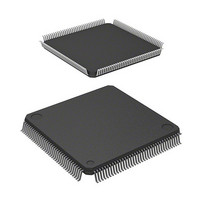R5F61662N50FPV Renesas Electronics America, R5F61662N50FPV Datasheet - Page 166

R5F61662N50FPV
Manufacturer Part Number
R5F61662N50FPV
Description
MCU 24KB FLASH 384K 144-LQFP
Manufacturer
Renesas Electronics America
Series
H8® H8SX/1600r
Datasheet
1.R0K561622S000BE.pdf
(1070 pages)
Specifications of R5F61662N50FPV
Core Processor
H8SX
Core Size
16/32-Bit
Speed
50MHz
Connectivity
EBI/EMI, I²C, IrDA, SCI, SmartCard, USB
Peripherals
DMA, LVD, POR, PWM, WDT
Number Of I /o
92
Program Memory Size
384KB (384K x 8)
Program Memory Type
FLASH
Ram Size
40K x 8
Voltage - Supply (vcc/vdd)
3 V ~ 3.6 V
Data Converters
A/D 8x10b; D/A 2x8b
Oscillator Type
External
Operating Temperature
-20°C ~ 75°C
Package / Case
144-LQFP
Lead Free Status / RoHS Status
Lead free / RoHS Compliant
Eeprom Size
-
Available stocks
Company
Part Number
Manufacturer
Quantity
Price
Company:
Part Number:
R5F61662N50FPV
Manufacturer:
Renesas Electronics America
Quantity:
10 000
- Current page: 166 of 1070
- Download datasheet (6Mb)
Section 6 Interrupt Controller
6.7
CPU Priority Control Function Over DTC and DMAC
The interrupt controller has a function to control the priority among the DTC, DMAC, and the
CPU by assigning different priority levels to the DTC, DMAC, and CPU. Since the priority level
can automatically be assigned to the CPU on an interrupt occurrence, it is possible to execute the
CPU interrupt exception handling prior to the DTC or DMAC transfer.
The priority level of the CPU is assigned by bits CPUP2 to CPUP0 in CPUPCR. The priority level
of the DTC is assigned by bits DTCP2 to DTCP0 in CPUPCR. The priority level of the DMAC is
assigned by bits DMAP2 to DMAP0 in DMDR for each channel.
The priority control function over the DTC and DMAC is enabled by setting the CPUPCE bit in
CPUPCR to 1. When the CPUPCE bit is 1, the DTC and DMAC activation sources are controlled
according to the respective priority levels.
The DTC activation source is controlled according to the priority level of the CPU indicated by
bits CPUP2 to CPUP0 and the priority level of the DTC indicated by bits DTCP2 to DTCP0. If the
CPU has priority, the DTC activation source is held. The DTC is activated when the condition by
which the activation source is held is cancelled (CPUPCE = 1 and value of bits CPUP2 to CPUP0
is greater than that of bits DTCP2 to DTCP0). The priority level of the DTC is assigned by the
DTCP2 to DTCP0 bits regardless of the activation source.
For the DMAC, the priority level can be specified for each channel. The DMAC activation source
is controlled according to the priority level of each DMAC channel indicated by bits DMAP2 to
DMAP0 and the priority level of the CPU. If the CPU has priority, the DMAC activation source is
held. The DMAC is activated when the condition by which the activation source is held is
cancelled (CPUPCE = 1 and value of bits CPUP2 to CPUP0 is greater than that of bits DMAP2 to
DMAP0). If different priority levels are specified for channels, the channels of the higher priority
levels continue transfer and the activation sources for the channels of lower priority levels than
that of the CPU are held.
There are two methods for assigning the priority level to the CPU by the IPSETE bit in CPUPCR.
Setting the IPSETE bit to 1 enables a function to automatically assign the value of the interrupt
mask bit of the CPU to the CPU priority level. Clearing the IPSETE bit to 0 disables the function
to automatically assign the priority level. Therefore, the priority level is assigned directly by
software rewriting bits CPUP2 to CPUP0. Even if the IPSETE bit is 1, the priority level of the
CPU is software assignable by rewriting the interrupt mask bit of the CPU (I bit in CCR or I2 to I0
bits in EXR).
Rev. 2.00 Sep. 16, 2009 Page 136 of 1036
REJ09B0414-0200
Related parts for R5F61662N50FPV
Image
Part Number
Description
Manufacturer
Datasheet
Request
R

Part Number:
Description:
KIT STARTER FOR M16C/29
Manufacturer:
Renesas Electronics America
Datasheet:

Part Number:
Description:
KIT STARTER FOR R8C/2D
Manufacturer:
Renesas Electronics America
Datasheet:

Part Number:
Description:
R0K33062P STARTER KIT
Manufacturer:
Renesas Electronics America
Datasheet:

Part Number:
Description:
KIT STARTER FOR R8C/23 E8A
Manufacturer:
Renesas Electronics America
Datasheet:

Part Number:
Description:
KIT STARTER FOR R8C/25
Manufacturer:
Renesas Electronics America
Datasheet:

Part Number:
Description:
KIT STARTER H8S2456 SHARPE DSPLY
Manufacturer:
Renesas Electronics America
Datasheet:

Part Number:
Description:
KIT STARTER FOR R8C38C
Manufacturer:
Renesas Electronics America
Datasheet:

Part Number:
Description:
KIT STARTER FOR R8C35C
Manufacturer:
Renesas Electronics America
Datasheet:

Part Number:
Description:
KIT STARTER FOR R8CL3AC+LCD APPS
Manufacturer:
Renesas Electronics America
Datasheet:

Part Number:
Description:
KIT STARTER FOR RX610
Manufacturer:
Renesas Electronics America
Datasheet:

Part Number:
Description:
KIT STARTER FOR R32C/118
Manufacturer:
Renesas Electronics America
Datasheet:

Part Number:
Description:
KIT DEV RSK-R8C/26-29
Manufacturer:
Renesas Electronics America
Datasheet:

Part Number:
Description:
KIT STARTER FOR SH7124
Manufacturer:
Renesas Electronics America
Datasheet:

Part Number:
Description:
KIT STARTER FOR H8SX/1622
Manufacturer:
Renesas Electronics America
Datasheet:

Part Number:
Description:
KIT DEV FOR SH7203
Manufacturer:
Renesas Electronics America
Datasheet:











